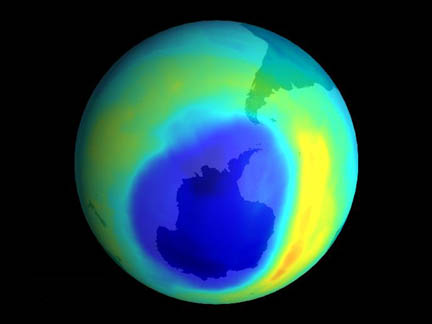Solution of the Kato Problem

Picture of the ozone hole over Antarctica, taken by a NASA satellite.
The process that leads to this is a diffusion, as studied in the Kato
problem.
Diffusion remains a central part of mathematics and physics, inspiring
influential work over the last three centuries. It has proven to
be an important model of a wide variety of phenomena, including heat flow
and chemical reactions. It is an essential part of the modeling
of atmospheric chemistry, as depicted in the picture above. The Kato problem
formed one part of this theory which recently has been completely resolved.
It asks for regularity of diffusions through an arbitrary choice
of medium, concentrating on the effects on diffusion as the medium
is allowed to change. Knowing this regularity, we can be more
confident of the predictions made with the aid of such models. In
the Kato problem, the material changes in a way that demands the
most refined estimate of regularity of diffusion. Such paradigms test our
understanding of the underlying physical process in the deepest way.
The resolution of this question had previously only been known completely
in one dimension, and that result by Coifman, Meyer and McIntosh was a
key development in harmonic analysis in the 1980s. In the intervening
years, many people made essential contributions to the question although
the most general formulation remained unresolved. The complete resolution
of the Kato problem in all dimensions has been achieved by mathematicians
in the US, France and Australia, Auscher, Hofmann, Lacey, McIntosh and
Tchamitchian. The US participants Hofmann and Lacey are supported
by the NSF. The resolution in all dimensions highlights previously
hidden relationships between the key aspects of the subject. Correspondingly
the analytic/synthetic tools we can bring to questions of this type
has now been enhanced. It also points to the important role
of international collaboration in the continued vitality of mathematics
in the U.S.
